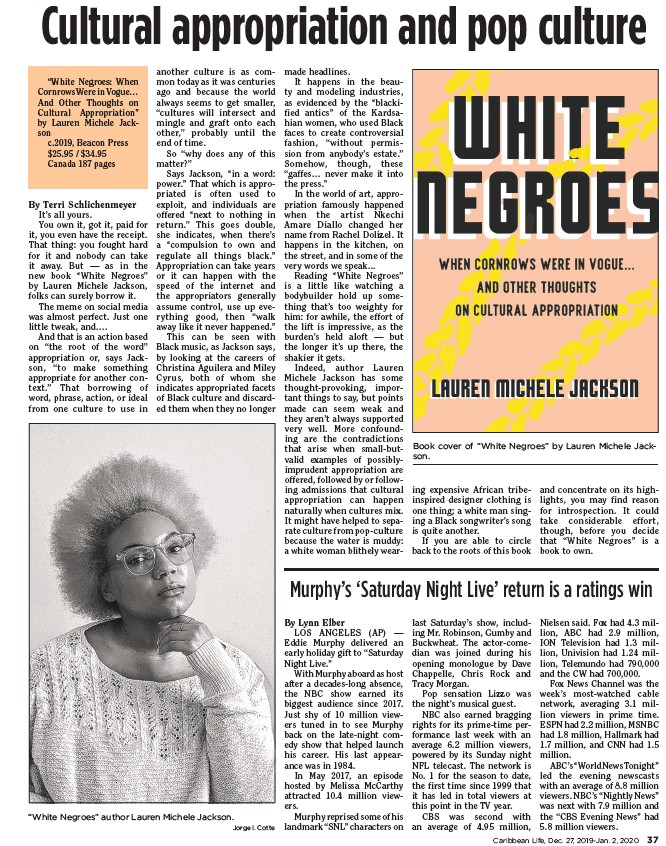
Cultural appropriation and pop culture
Murphy’s ‘Saturday Night Live’ return is a ratings win
Caribbean Life, Dec. 27, 2019-Jan. 2, 2020 37
By Terri Schlichenmeyer
It’s all yours.
You own it, got it, paid for
it, you even have the receipt.
That thing: you fought hard
for it and nobody can take
it away. But — as in the
new book “White Negroes”
by Lauren Michele Jackson,
folks can surely borrow it.
The meme on social media
was almost perfect. Just one
little tweak, and….
And that is an action based
on “the root of the word”
appropriation or, says Jackson,
“to make something
appropriate for another context.”
That borrowing of
word, phrase, action, or ideal
from one culture to use in
another culture is as common
today as it was centuries
ago and because the world
always seems to get smaller,
“cultures will intersect and
mingle and graft onto each
other,” probably until the
end of time.
So “why does any of this
matter?”
Says Jackson, “in a word:
power.” That which is appropriated
is often used to
exploit, and individuals are
offered “next to nothing in
return.” This goes double,
she indicates, when there’s
a “compulsion to own and
regulate all things black.”
Appropriation can take years
or it can happen with the
speed of the internet and
the appropriators generally
assume control, use up everything
good, then “walk
away like it never happened.”
This can be seen with
Black music, as Jackson says,
by looking at the careers of
Christina Aguilera and Miley
Cyrus, both of whom she
indicates appropriated facets
of Black culture and discarded
them when they no longer
“White Negroes” author Lauren Michele Jackson.
Jorge I. Cotte
made headlines.
It happens in the beauty
and modeling industries,
as evidenced by the “blackified
antics” of the Kardsahian
women, who used Black
faces to create controversial
fashion, “without permission
from anybody’s estate.”
Somehow, though, these
“gaffes… never make it into
the press.”
In the world of art, appropriation
famously happened
when the artist Nkechi
Amare Diallo changed her
name from Rachel Dolizel. It
happens in the kitchen, on
the street, and in some of the
very words we speak...
Reading “White Negroes”
is a little like watching a
bodybuilder hold up something
that’s too weighty for
him: for awhile, the effort of
the lift is impressive, as the
burden’s held aloft — but
the longer it’s up there, the
shakier it gets.
Indeed, author Lauren
Michele Jackson has some
thought-provoking, important
things to say, but points
made can seem weak and
they aren’t always supported
very well. More confounding
are the contradictions
that arise when small-butvalid
examples of possiblyimprudent
appropriation are
offered, followed by or following
admissions that cultural
appropriation can happen
naturally when cultures mix.
It might have helped to separate
culture from pop-culture
because the water is muddy:
a white woman blithely wearing
expensive African tribeinspired
designer clothing is
one thing; a white man singing
a Black songwriter’s song
is quite another.
If you are able to circle
back to the roots of this book
and concentrate on its highlights,
you may find reason
for introspection. It could
take considerable effort,
though, before you decide
that “White Negroes” is a
book to own.
“White Negroes: When
Cornrows Were in Vogue…
And Other Thoughts on
Cultural Appropriation”
by Lauren Michele Jackson
c.2019, Beacon Press
$25.95 / $34.95
Canada 187 pages
Book cover of “White Negroes” by Lauren Michele Jackson.
By Lynn Elber
LOS ANGELES (AP) —
Eddie Murphy delivered an
early holiday gift to “Saturday
Night Live.”
With Murphy aboard as host
after a decades-long absence,
the NBC show earned its
biggest audience since 2017.
Just shy of 10 million viewers
tuned in to see Murphy
back on the late-night comedy
show that helped launch
his career. His last appearance
was in 1984.
In May 2017, an episode
hosted by Melissa McCarthy
attracted 10.4 million viewers
.M
urphy reprised some of his
landmark “SNL” characters on
last Saturday’s show, including
Mr. Robinson, Gumby and
Buckwheat. The actor-comedian
was joined during his
opening monologue by Dave
Chappelle, Chris Rock and
Tracy Morgan.
Pop sensation Lizzo was
the night’s musical guest.
NBC also earned bragging
rights for its prime-time performance
last week with an
average 6.2 million viewers,
powered by its Sunday night
NFL telecast. The network is
No. 1 for the season to date,
the first time since 1999 that
it has led in total viewers at
this point in the TV year.
CBS was second with
an average of 4.95 million,
Nielsen said. Fox had 4.3 million,
ABC had 2.9 million,
ION Television had 1.3 million,
Univision had 1.24 million,
Telemundo had 790,000
and the CW had 700,000.
Fox News Channel was the
week’s most-watched cable
network, averaging 3.1 million
viewers in prime time.
ESPN had 2.2 million, MSNBC
had 1.8 million, Hallmark had
1.7 million, and CNN had 1.5
million.
ABC’s “World News Tonight”
led the evening newscasts
with an average of 8.8 million
viewers. NBC’s “Nightly News”
was next with 7.9 million and
the “CBS Evening News” had
5.8 million viewers.